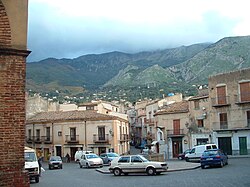
Palermo is a city of Southern Italy, the capital of both the autonomous region of Sicily and the Metropolitan City of Palermo. The city is noted for its history, culture, architecture and gastronomy, playing an important role throughout much of its existence; it is over 2,700 years old. Palermo is located in the northwest of the island of Sicily, right by the Gulf of Palermo in the Tyrrhenian Sea.

Monreale is a town and comune in the Metropolitan City of Palermo, in Sicily, southern Italy. It is located on the slope of Monte Caputo, overlooking the very fertile valley called "La Conca d'oro", a production area of orange, olive and almond trees, the produce of which is exported in large quantities. The town, which has a population of approximately 39,000, is about 15 kilometres inland (south) of Palermo, the regional capital.
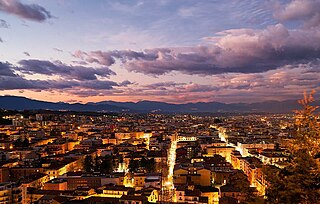
Cosenza is a city in the Calabria region of Southern Italy. The municipal population is of around 70,000, but the urban area counts over 268,000 inhabitants. It is the capital of the Province of Cosenza, which has a population of around 735,000. The demonym of Cosenza is cosentino in Italian and Cosentian in English.

Petralia Sottana is a town and comune in the Metropolitan City of Palermo, in the island of Sicily, southern Italy. The main characters in Emanuele Crialese's 2006 film of Sicilian immigration to America, Nuovomondo, come from the town of Petralia.

Randazzo is a town and comune in the Metropolitan City of Catania, Sicily, southern Italy. It is situated at the northern foot of Mount Etna, c. 70 kilometres (43 mi) northwest of Catania. It is the nearest town to the summit of Etna, and is one of the points from which the ascent may be made.
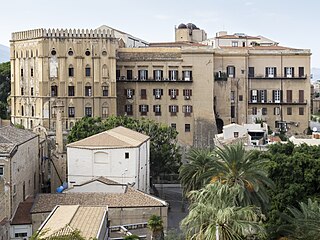
The Palazzo dei Normanni or Royal Palace of Palermo is a palace in Palermo, Italy. It was the seat of the Kings of Sicily during the Norman domination and served afterwards as the main seat of power for the subsequent rulers of Sicily. Currently, it is the seat of the Sicilian Regional Assembly. The building is the oldest royal residence in Europe; and was the private residence of the rulers of the Kingdom of Sicily and the imperial seat of Frederick II and Conrad IV.

Teggiano is a town and comune in Campania, Italy, in the province of Salerno. It is situated on an isolated eminence above the upper part of the valley to which it gives the name of Vallo di Diano.
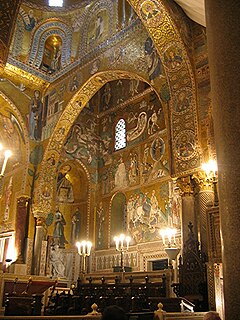
The Palatine Chapel, is the royal chapel of the Norman kings of Sicily situated on the first floor at the center of the Palazzo Reale in Palermo, Sicily.

Nicosia (Gallo-Italic of Sicily: Nẹcọscia; Sicilian: Nicusìa: Greek: Λευκωσία - Lefkosia; is a village and comune of the province of Enna in Sicily, southern Italy. Nicosia, along with Troina are the northernmost towns in the province of Enna. The vicinity traditionally contained are salt mines and arable lands.
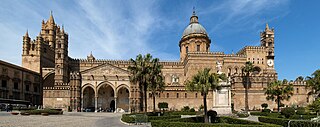
Palermo Cathedral is the cathedral church of the Roman Catholic Archdiocese of Palermo, located in Palermo, Sicily, southern Italy. It is dedicated to the Assumption of the Virgin Mary. As an architectural complex, it is characterized by the presence of different styles, due to a long history of additions, alterations and restorations, the last of which occurred in the 18th century.

The Martorana Also Co-Cathedral of St. Mary of the Admiral is the seat of the parish of San Nicolò dei Greci, a Co-cathedral overlooking the Piazza Bellini in Palermo, Sicily, southern Italy. The church belongs to the Eparchy of Piana degli Albanesi of the Italo-Albanian Catholic Church, a diocese which includes the Albanian communities in Sicily who officiate the liturgy according to the Byzantine Rite in the ancient Greek language.

Arienzo is a town and comune in the Province of Caserta, Campania, southern Italy. It is located across the Appian Way.

Gangi is a comune (municipality) in the Metropolitan City of Palermo in the Italian region Sicily, located about 80 kilometres (50 mi) southeast of Palermo.

Casalvecchio Siculo is a comune (municipality) in the Metropolitan City of Messina in the Italian region Sicily, located about 170 kilometres (110 mi) east of Palermo and about 35 kilometres (22 mi) southwest of Messina.
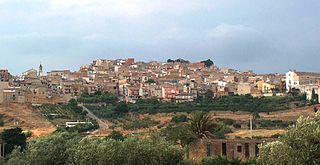
Cianciana is a comune (municipality) in the Province of Agrigento in the Italian region Sicily, located in the middle valley of the Platani river, about 70 kilometres (43 mi) south of Palermo and about 25 kilometres (16 mi) northwest of Agrigento. The Monte Cammarata, elevation 1,579 metres (5,180 ft) above sea level, part of the Monti Sicani chain, is nearby.

Militello in Val di Catania is a comune (municipality) in the Metropolitan City of Catania in the Italian region Sicily, located about 160 kilometres (99 mi) southeast of Palermo and about 35 kilometres (22 mi) southwest of Catania, on the last slopes of the Hyblaean Mountains. It has a railway station on the line Catania-Gela.
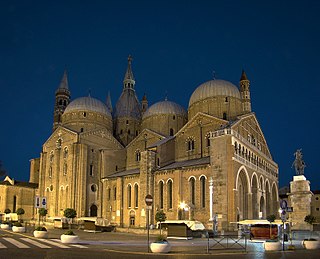
The Pontifical Basilica of Saint Anthony of Padua is a Roman Catholic church and minor basilica in Padua, Veneto, Northern Italy, dedicated to St. Anthony. Although the Basilica is visited as a place of pilgrimage by people from all over the world, it is not the titular cathedral of the city, a title belonging to the Cathedral-Basilica of St. Mary of Padua. The basilica is known locally as "il Santo". It is one of the eight international shrines recognized by the Holy See.
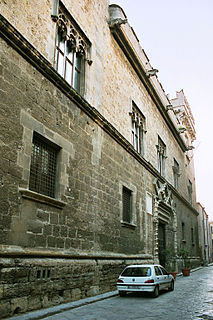
Palazzo Abatellis is a palace in Palermo, Sicily, southern Italy, located in the Kalsa quarter. It is home to the Galleria Regionale della Sicilia, the Gallery of Art for the Sicilian region.

The Basilica of Our Lady's Assumption is a 14th-century basilica in Alcamo, province of Trapani, Sicily, southern Italy. It is named after the Assumption.

The Church of Saint Catherine is a church in Palermo, Sicily, southern Italy. It is located in the heart of the historic centre, between Piazza Bellini and Piazza Pretoria, in the same area of other well-known architectural landmarks like the churches of Martorana and San Cataldo, the Fontana Pretoria and the Palazzo Pretorio, headquarters of the Palermo municipality. The church is a synthesis of Sicilian Baroque, Rococo and Renaissance styles.
